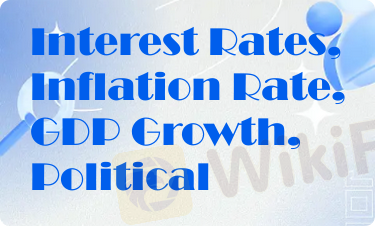
2025-02-12 04:24
In der IndustrieTHE ROLE OF ECONOMIC INDICATORS IN FOREX TRENDS
#firstdealofthenewyearastylz
Economic indicators play a crucial role in shaping forex (foreign exchange) market trends, as they provide insights into a country's economic health and influence investor sentiment. Traders and investors use these indicators to predict currency movements and make informed trading decisions. Below are the key economic indicators and their impact on forex trends:
1. Interest Rates (Central Bank Policies)
Central banks (e.g., the Federal Reserve, European Central Bank) set interest rates, which directly impact currency values.
Higher interest rates attract foreign investment, increasing demand for the currency.
Lower interest rates lead to capital outflows, weakening the currency.
2. Inflation Rate (Consumer Price Index - CPI, Producer Price Index - PPI)
Moderate inflation is positive for a currency, signaling economic stability.
High inflation reduces purchasing power, weakening the currency.
Low inflation/deflation may indicate weak demand and economic slowdown, affecting forex markets negatively.
3. Gross Domestic Product (GDP) Growth
GDP measures overall economic output.
Strong GDP growth boosts currency value as it signals a robust economy.
Weak GDP growth can lead to currency depreciation due to reduced investor confidence.
4. Employment Data (Non-Farm Payrolls - NFP, Unemployment Rate)
A low unemployment rate signals economic strength, attracting investors and strengthening the currency.
A high unemployment rate suggests economic weakness, leading to currency depreciation.
The U.S. NFP report, released monthly, has a major impact on the forex market.
5. Trade Balance (Exports vs. Imports, Current Account)
A trade surplus (exports > imports) strengthens the domestic currency due to higher foreign demand.
A trade deficit (imports > exports) weakens the currency, as more local currency is sold to buy foreign goods.
6. Consumer & Business Confidence (PMI, Retail Sales, Consumer Sentiment)
Purchasing Managers’ Index (PMI): Measures business activity; a reading above 50 indicates economic expansion.
Retail Sales: Strong retail sales suggest consumer confidence and economic growth, supporting currency strength.
Consumer Confidence Index (CCI): Higher confidence boosts spending and currency value.
7. Political and Geopolitical Events
Elections, policy changes, and geopolitical tensions (e.g., wars, trade disputes) can cause forex volatility.
Political stability attracts foreign investment, strengthening the currency.
Uncertainty or crises lead to risk aversion, often strengthening safe-haven currencies like the U.S. dollar (USD), Swiss franc (CHF), and Japanese yen (JPY).
8. Market Sentiment and Speculation
Traders’ expectations based on upcoming data releases can influence forex trends.
Hawkish central bank signals (indicating rate hikes) strengthen a currency, while dovish signals (rate cuts) weaken it.
Gefällt 0

General Solo
Broker
Aktueller Inhalt
In der Industrie
Event-A comment a day,Keep rewards worthy up to$27
In der Industrie
Nigeria Event Giveaway-Win₦5000 Mobilephone Credit
In der Industrie
Nigeria Event Giveaway-Win ₦2500 MobilePhoneCredit
In der Industrie
South Africa Event-Come&Win 240ZAR Phone Credit
In der Industrie
Nigeria Event-Discuss Forex&Win2500NGN PhoneCredit
In der Industrie
[Nigeria Event]Discuss&win 2500 Naira Phone Credit
Kategorie

Plattform

Ausstellung

IB

Rekrutierung

EA

In der Industrie

Markt

Index
THE ROLE OF ECONOMIC INDICATORS IN FOREX TRENDS
 Hong Kong | 2025-02-12 04:24
Hong Kong | 2025-02-12 04:24#firstdealofthenewyearastylz
Economic indicators play a crucial role in shaping forex (foreign exchange) market trends, as they provide insights into a country's economic health and influence investor sentiment. Traders and investors use these indicators to predict currency movements and make informed trading decisions. Below are the key economic indicators and their impact on forex trends:
1. Interest Rates (Central Bank Policies)
Central banks (e.g., the Federal Reserve, European Central Bank) set interest rates, which directly impact currency values.
Higher interest rates attract foreign investment, increasing demand for the currency.
Lower interest rates lead to capital outflows, weakening the currency.
2. Inflation Rate (Consumer Price Index - CPI, Producer Price Index - PPI)
Moderate inflation is positive for a currency, signaling economic stability.
High inflation reduces purchasing power, weakening the currency.
Low inflation/deflation may indicate weak demand and economic slowdown, affecting forex markets negatively.
3. Gross Domestic Product (GDP) Growth
GDP measures overall economic output.
Strong GDP growth boosts currency value as it signals a robust economy.
Weak GDP growth can lead to currency depreciation due to reduced investor confidence.
4. Employment Data (Non-Farm Payrolls - NFP, Unemployment Rate)
A low unemployment rate signals economic strength, attracting investors and strengthening the currency.
A high unemployment rate suggests economic weakness, leading to currency depreciation.
The U.S. NFP report, released monthly, has a major impact on the forex market.
5. Trade Balance (Exports vs. Imports, Current Account)
A trade surplus (exports > imports) strengthens the domestic currency due to higher foreign demand.
A trade deficit (imports > exports) weakens the currency, as more local currency is sold to buy foreign goods.
6. Consumer & Business Confidence (PMI, Retail Sales, Consumer Sentiment)
Purchasing Managers’ Index (PMI): Measures business activity; a reading above 50 indicates economic expansion.
Retail Sales: Strong retail sales suggest consumer confidence and economic growth, supporting currency strength.
Consumer Confidence Index (CCI): Higher confidence boosts spending and currency value.
7. Political and Geopolitical Events
Elections, policy changes, and geopolitical tensions (e.g., wars, trade disputes) can cause forex volatility.
Political stability attracts foreign investment, strengthening the currency.
Uncertainty or crises lead to risk aversion, often strengthening safe-haven currencies like the U.S. dollar (USD), Swiss franc (CHF), and Japanese yen (JPY).
8. Market Sentiment and Speculation
Traders’ expectations based on upcoming data releases can influence forex trends.
Hawkish central bank signals (indicating rate hikes) strengthen a currency, while dovish signals (rate cuts) weaken it.
Gefällt 0
Ich möchte auch kommentieren
Einreichen
0Kommentare

Es gibt noch keinen Kommentar. Mach den ersten

Einreichen
Es gibt noch keinen Kommentar. Mach den ersten